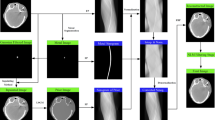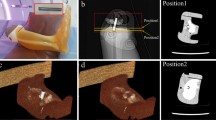Abstract
The purpose of this study was to improve metal artifact reduction (MAR) in X-ray computed tomography (CT) by the combination of two artifact reduction methods. The presented method constitutes an image-based weighted superposition of images processed with two known methods for MAR: linear interpolation of reprojected metal traces (LI) and multi-dimensional adaptive filtering of the raw data (MAF). Two weighting concepts were realized that take into account mean distances of image points from metal objects or additional directional components. Artifact reduction on patient data from the jaw and the hip region shows that although the application of only one of the MAR algorithms can already improve image quality, these methods have specific drawbacks. While MAF does not correct corrupted CT values, LI often introduces secondary artifacts. The corrective impact of the merging algorithm is almost always superior to the application of only one of the methods. The results obtained with directional weighting are equal to or in many cases better than those of the distance weighting scheme. Merging combines the advantages of two fundamentally different approaches to artifact reduction and can improve the quality of images that are affected by metal artifacts.





Similar content being viewed by others
Abbreviations
- LI:
-
linear interpolation algorithm
- MAF:
-
multi-dimensional adaptive filtering algorithm
- MAR:
-
metal artifact reduction
- f(x, y):
-
object function at (x, y)
- F(ϑ), F(ξ):
-
normalized filter function in the direction of the coordinates ϑ and ξ
- I :
-
primary X-ray intensity
- I 0 :
-
transmitted X-ray intensity
- N D :
-
number of detectors per detector row
- p :
-
attenuation
- p(β,α), p(ϑ,ξ):
-
projection data (fan and parallel geometry)
- p th :
-
lower threshold of the attenuation of adaptive filtering
- p max :
-
maximum value of the attenuation of adaptive filtering
- (x, y):
-
image point
- α :
-
projection angle in fan geometry
- β :
-
angle within the fan relative to the central ray
- Δα, Δβ, Δz, Δϑ, Δξ :
-
minimum functions for adaptive filtering
- ϑ :
-
projection angle in parallel geometry
- ξ :
-
orthogonal distance of a ray to the center of rotation in parallel geometry
References
Hsieh J (1995) Image artifacts, causes, and correction. In: Goldman LW, Fowlkes JB (eds) Medical CT and ultrasound, current technology and applications. Advanced Medical Publishing, Madison, pp 487–518
Kamel EM, Burger C, Buck A, von Schulthess GK, Goerres GW (2003) Impact of metallic dental implants on CT-based attenuation correction in a combined PET/CT scanner. Eur Radiol 13:724–728
Wang G, Snyder DL, O’Sullivan JA, Vannier MW (1996) Iterative deblurring for metal artifact reduction. IEEE Trans Med Imaging 15:657–664
Wang G, Vannier MW, Cheng PC (1999) Iterative X-ray cone-beam tomography for metal artifact reduction and local region reconstruction. Microsc Microanal 5:58–65
Wang G, Frei T, Vannier MW (2000) A fast iterative algorithm for metal artifact reduction in X-ray CT. Acad Radiol 7:607–614
De Man B, Nuyts J, Dupont P, Marchal G, Suetens P (2000) Reduction of metal streak artifacts in X-ray computed tomography using a transmission maximum a posteriori algorithm. IEEE Trans Nucl Sci 47:997–981
Zhao S, Robertson DD, Wang G, Whiting B, Bae KT (2000) X-ray CT metal artifact reduction using wavelets: an application for imaging total hip prostheses. IEEE Trans Med Imaging 19:1238–1247
Glover GH, Pelc NJ (1981) An algorithm for the reduction of metal clip artifacts in CT reconstructions. Med Phys 8:799–807
Kalender WA, Hebel R, Ebersberger J (1987) Reduction of CT artifacts caused by metallic implants. Radiology 164:576–577
Kachelriess M, Watzke O, Kalender WA (2001) Generalized multi-dimensional adaptive filtering (MAF) for conventional and spiral single-slice, multi-slice and cone-beam CT. Med Phys 28:457–490
Restrepo A, Bovik AC (1988) Adaptive trimmed mean filters for image restoration. IEEE Trans Acoustic, Speech, Signal Process 36:1326–1337
Hsieh J (1998) Adaptive streak artifact reduction in computed tomography resulting from excessive X-ray photon noise. Med Phys 25:2139–2147
Watzke O (2002) Metallartefaktreduktion in der Computertomographie. In: Kalender WA (ed) Berichte aus dem Institut für Medizinische Physik, vol 8. Shaker Verlag, Aachen
Acknowledgment
This work was supported by Grant no. AZ 286/98 of the Bayerische Forschungsstiftung, Munich, Germany.
Author information
Authors and Affiliations
Corresponding author
Rights and permissions
About this article
Cite this article
Watzke, O., Kalender, W.A. A pragmatic approach to metal artifact reduction in CT: merging of metal artifact reduced images. Eur Radiol 14, 849–856 (2004). https://doi.org/10.1007/s00330-004-2263-y
Received:
Revised:
Accepted:
Published:
Issue Date:
DOI: https://doi.org/10.1007/s00330-004-2263-y




